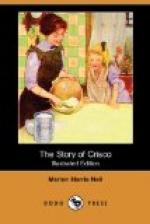4 tablespoonfuls sugar 2 eggs 4 tablespoonfuls Crisco 1 cupful flour 1/2 teaspoonful baking powder 1/4 teaspoonful salt 1/2 teaspoonful lemon extract Preserves Pastry
Cream Crisco and sugar, then add eggs well beaten, flour, salt, baking powder, and extract. Line twelve tartlet tins with pastry, put teaspoonful of preserves in each, then divide mixture into them, and bake in moderately hot oven twenty minutes.
Sufficient for twelve tartlets.
[Illustration]
BREADS &c.
[Illustration]
The usual method of making bread is to ferment dough with yeast; the latter acts upon certain constituents in the flour ultimately producing a gas which permeates the dough. The dough is placed in a very hot oven, the heat kills the yeast plant, the gas expands with the heat, still raising the dough. The loaf is set in shape, and, when finally cooked and the gas all escaped, will be found to be light and full of tiny holes. Certain factors hasten or delay these changes. A moist, warm medium being most favorable to the growth of the yeast, the water should just be lukewarm; then a good flour, containing about 8 per cent of gluten is necessary. This gluten is the proteid in flour; when well mixed with water it forms a viscid elastic substance, hence it is necessary to well knead dough to make it more springy, so that when the gas is generated in it, it will expand and take the form of a sponge, and thus prevent the gas from escaping. The bread must be put into a very hot oven at first, 340 deg. F., so that the yeast plant is killed quickly. If this be not accomplished soon, the loaf may go on spreading in the oven, and, if not sour in taste, will not be of such a good flavor.
Plenty of salt in dough is said to strengthen the gluten, give a good flavor to the bread, and keep it moist for a longer time, but it rather retards the working of the yeast. Flour also may be made into a light loaf by using baking powder to produce the gas. This is a much quicker process, but the bread is not liked so universally as when made with yeast. For, when yeast is used, other changes take place in the dough besides the production of the gas, that seem to give bread the characteristic flavor constantly welcome by the palate. Good flour has a slight pure smell, free from any moldy odor.
[Illustration]
Yeast is a fungoid growth, a microscopic plant capable of starting a fermentation in various substances. It grows rapidly in a favorable medium, as when mixed with flour and water, and kept in a warm place, resulting in setting up fermentation. Baking powders are composed of an acid and an alkali. Some kind of flour usually is added to keep them dry and free from lumps. When the mixture containing the baking powder is moistened the acid and the alkali chemically combine and alter, a gas being generated. If the articles be placed soon in great heat, the gas is warmed, expands, and in its endeavor to escape raises the mass. The heat sets the mixture in this raised condition, thus the cake or pudding is rendered light, easier to masticate and digest.




